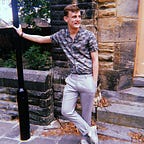Brainy Behaviour
Things end up the same and in all the same places
It’s because of Hotelling’s Law and it’s bad for the customer
Ever thought you were going mad looking for a take-out food restaurant, then suddenly they all appear within the same block? wtf right?
You’re not going mad — the clustering of eateries happens wherever market competition exists. This phenomenon is known as Hotelling’s Law and its rather inconvenient for the customer. It’s a simple example of game theory, with psychological human behaviour at its root.
Such circles of customers may be said to make every entrepreneur a monopolist within a limited class and region — and there is no monopoly which is not confined to a limited class and region. Harold Hotelling, Stability in Competition, March 1929
What is Hotelling’s Law?
First noted by Harold Hotelling in the Economic Journal in 1929, the effect is a direct result of market competition. The behaviour is often well explained with ice cream trucks.
Take for example a sunny beach bay, full of people tanning their dons. The optimal position for a single ice cream truck to position to have greatest customer reach is in the middle of the beach [A]. Being central means that everyone has a maximum journey to the van which is less than half the length of the beach. Intuitive huh?
Now lets take the situation where Mister Whippy wants a scoop of Jerry Greenfield’s turf. Where does it park?
If we divide the beach in half, the trucks could each park in the centre of their allocated halves [B].
This situation is best for the beach-goers since at worst they will only ever have to walk along a quarter of the beach to reach their nearest icey-whip. Each business has a captive market of around 40% of the beach goers — with around 20% in the middle who might walk either way.
The problem occurs when Jerry wants to take some turf back — or Whippy gets greedy. If either truck parks closer to the centre, it will steal business from the other [C] — as long as we assume the businesses are equally attractive to customers, so that they simply walk to the nearest truck.
This is bad for business, for the losing truck, so it too will move to its boundary — resulting in scenario [D]. Both businesses now have half of the beach-punters as customers. As you will have already noticed, this isn’t dissimilar from in [B], however here many customers will have to walk further to get to the nearest van — consider those at either edge of the beach.
So the most inconvenient model for the customer is the one which prevails.
Look alike fridge; same McMenu
This effect also translates to other business settings. It’s the reason why the menus in fast food restaurants have the same offerings at such similar prices. When people want fast food — usually fries and a burger — there’s an expectation of quality, taste and cost. A fast food restaurant offering a higher quality burger for double the price would inherently struggle. It just wouldn’t attract business whilst clinging onto the fast food tag, associated with lower quality, budget friendly food.
It’s also the reason why fridge-freezers in similar price brackets look the same. When shopping, the customer will be more inclined to go for the model which is more feature rich. Things like having an ice maker, water dispenser or double doors. Manufacturers know this and will often develop their product to be as similar to the ‘average’ product as possible.
Frankly, this seems like the seed for a dystopian word, where every menu is the same and every item for sale in she shops is like for like. The quirks and niches disappear and suddenly things become uninteresting.
Breaking the mould
Of course, going against the norm to offer something different and doing it well can win customers. High risk, high reward. Going back to fridges, lets look at an example. SMEG are known for their 50’s style retro fridge freezers. They retail in the UK for just over £1500.
That same amount of dosh could get you a swanky LG Smart fridge, which is feature rich. It has an ice+water dispenser and instaview (which just means the front window turns transparent, like a peep show for your veggies—wrongly interpreted as an Instagram live stream capable fridge).
But SMEG choose to stand out. They don’t copy the competitor, nor do they aim for the median design. By being different, they attract custom. People don’t candidly purchase a SMEG, they do it for the design — and are willing to pay double what you’d expect for a comparable fridge.
Fin.
Business brain: Be bold and be remembered for it. Offer people something better, something different. Don’t just launch an average idea into a cloudy market.
Consumer conscience: Don’t shop the middle, walk the extra mile; spend an extra penny. More than likely, you’ll be rewarded for the quality and you’ll have something more unique to show of it.
